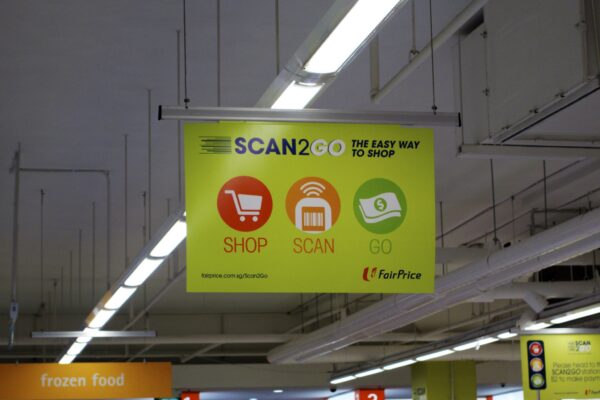
This is one of the newest supermarket shopping gadgetry. It’s in NTUC Fairprice. No, it’s not yet another self-checkout kiosk. The idea here is that you scan your shopping as you go along, so that when you reach the checkout counter, your shopping is already all scanned, you already know your total amount due, and all you have to do is to make payment. NTUC Fairprice calls this Scan2Go.
The idea, basically, is to get you to scan your own shopping so that no time is required to scan items at the checkout counter. This means faster checkout queues. That’s the theory, at least. There is no doubt that some time will be saved, but I do have some reservations about the overall effectiveness of this scheme.
Let’s talk about how Scan2Go works first.
You do have to sign up for the program first. After your application has been processed, you get a Scan2Go card. You can then go shopping with Scan2Go.
When you arrive at the supermarket, look out for the Scan2Go kiosk. Scan your Scan2Go card to checkout the reader. The Scan2Go reader contains a barcode reader, has a LCD screen to display information about your shopping, and a couple of buttons for you to interact with it.
As you pick up items, scan the barcodes on their packaging, then put them in your trolley. The screen shows the items you’ve scanned, and keeps a running total of the bill.
If you scanned something wrongly (or you decide not to buy it after all), you can remove the item. The reader also shows you the amount of “savings” you’ve earned from various discounts.
Of course, you can decide to scan everything at the end. But the purpose of scanning along the way is to avoid a big scanning frenzy at the end (either by yourself or by your cashier). You also don’t want to lose track of what you’ve scanned or not scanned.
For items that need weighing, you weigh the items at the weighing station first, then scan the label that’s printed out.
Here’s how I found the scanning experience:
- Scanning is mostly easy. But there are times where certain items are difficult to scan, possibly because the label is not flat, not clear, or just not readable for one reason or other. Imagine those vacuum packed items in a plastic bag, the label surface could be rather uneven and difficult for you to straighten them out.
- I think, being non-experts at barcode scanning, we don’t scan as efficiently as the cashiers. The cashiers can really scan super fast. If you only have a handful of items, I don’t think scanning yourself really saves that much time. But sure, it will make a big difference, if you have a full trolley load.
Right now, I love using Scan2Go because there’s usually no one at the dedicated Scan2Go checkout counters. At the NTUC Fairprice branch I go, the checkout counters usually have very long queues! With Scan2Go, I get to to the cashier right away, no waiting.
But in the long run, I’m not sure if this will really help a lot. You see, the queue at the checkout is slow not just because of scanning. You have to bag the items too. I’m not sure if the NTUC Fairprice’s idea is for customers to do their own bagging. A few times, the cashier left me to do my bagging. I know I’m definitely doing it way slower than they could have done. I will hold up and block the queue from advancing if I have lots of items to bag.
There were other times the cashier helped me to bag. It may be because there wasn’t any other work to do. Well, they bag faster than I can do. However, if the cashier has to do the bagging, I’m not sure how much time is saved by skipping the barcode scanning step? (Actually there is a random scan of 5 items that the cashier has to do. Not many, of course, when you have a full trolley load.)
Scan2Go may help improve checkout speeds slightly. Not a big deal, in my opinion. The more fun thing is about watching your bill as you shop. They could also add more shopping tools on the gadget too. Maybe point out to you that certain items you’ve picked up get a discount if you buy more of them.
On the other hand, one could argue that using Scan2Go is surely more efficient than self-checkout, where you do all the scanning at the self-checkout kiosk. Just look at how people struggle to use the kiosk. Yes, the real human cashier will do the work much faster.
